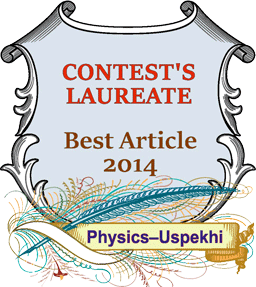 |
RSS feeds |
|
|||||
| Issue 12, 2025 |
|
||||||
|
|
|
||||||
Issues/2014/December |
← → |
| Physics of our days |
Review of scientific topics for Millimetron space observatory
a Astro Space Centre, Lebedev Physical Institute, Russian Academy of Sciences, ul. Profsoyuznaya 84/32, Moscow, 117997, Russian Federation
b Niels Bohr International Academy, Niels Bohr Institute, Blegdamsvej 17, Copenhagen, DK-2100, Denmark
c Institute of Astronomy, Russian Academy of Sciences, ul. Pyatnitskaya 48, Moscow, 119017, Russian Federation
d Lomonosov Moscow State University, Shternberg State Astronomical Institute, Universitetskii prosp. 13, Moscow, 119234, Russian Federation
e Federal Research Center A.V. Gaponov-Grekhov Institute of Applied Physics of the Russian Academy of Sciences, ul. Ulyanova 46, Nizhny Novgorod, 603000, Russian Federation
f N.I. Lobachevskii Nizhnii Novgorod State University, prosp. Gagarina 23, Nizhnii Novgorod, Russian Federation
g Astro Space Center, Lebedev Physical Institute, Russian Academy of Sciences, Pushchino Radio Astronomy Observatory, Pushchino, Moscow Region, Russian Federation
h Space Research Institute, Russian Academy of Sciences, Profsoyuznaya str. 84/32, Moscow, 117997, Russian Federation
i Ural Federal University, Institute of Natural Sciences, Astronomical Observatory, prosp. Lenina 51, Ekaterinburg, 620000, Russian Federation
j Southern Federal University, Bolshaya Sadovaya Str. 105/42, Rostov-on-Don, 344006, Russian Federation

This paper reviews a wide range of problems in astrophysics and cosmology that can be solved by means of astronomical observations in the far-IR to millimeter wavelength range and which include the formation and evolution of stars and planets, galaxies and the interstellar medium, the study of black holes, and the development of the cosmological model. These problems are considered in relation to the Millimetron space observatory (project Spectr-M), which is equipped with a cooled 10-meter mirror and can potentially operate both as a single-dish telescope and as part of a space-ground very long baseline interferometer.
|
PACS: 07.87.+v, 95.55.−n, 97.10.−q, 98.62.−g, 98.80.−k ()
DOI: URL: https://ufn.ru/en/articles/2014/12/c/  000350894500003 000350894500003  2014PhyU...57.1199K 2014PhyU...57.1199K Citation: Kardashev N S, Novikov I D, Lukash V N, Pilipenko S V, Mikheeva E V, Bisikalo D V, Wiebe D Z, Doroshkevich A G, Zasov A V, Zinchenko I I, Ivanov P B, Kostenko V I, Larchenkova T I, Likhachev S F, Malov I F, Malofeev V M, Pozanenko A S, Smirnov A V, Sobolev A M, Cherepashchuk A M, Shchekinov Yu A "Review of scientific topics for Millimetron space observatory" Phys. Usp. 57 1199–1228 (2014) Received: 31st, July 2014, accepted: 5th, August 2014 Оригинал: Кардашёв Н С, Новиков И Д, Лукаш В Н, Пилипенко С В, Михеева Е В, Бисикало Д В, Вибе Д З, Дорошкевич А Г, Засов А В, Зинченко И И, Иванов П Б, Костенко В И, Ларченкова Т И, Лихачёв С Ф, Малов И Ф, Малофеев В М, Позаненко А С, Смирнов А В, Соболев А М, Черепащук А М, Щекинов Ю А «Обзор научных задач для обсерватории Миллиметрон» УФН 184 1319–1352 (2014); |
|
© 1918–2025 Uspekhi Fizicheskikh Nauk Email: ufn@ufn.ru Editorial office contacts About the journal Terms and conditions |